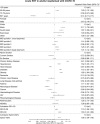Acute kidney injury in patients hospitalized with COVID-19 from the ISARIC WHO CCP-UK Study: a prospective, multicentre cohort study
- PMID: 34661677
- PMCID: PMC8788218
- DOI: 10.1093/ndt/gfab303
Acute kidney injury in patients hospitalized with COVID-19 from the ISARIC WHO CCP-UK Study: a prospective, multicentre cohort study
Abstract
Background: Acute kidney injury (AKI) is common in coronavirus disease 2019 (COVID-19). This study investigated adults hospitalized with COVID-19 and hypothesized that risk factors for AKI would include comorbidities and non-White race.
Methods: A prospective multicentre cohort study was performed using patients admitted to 254 UK hospitals with COVID-19 between 17 January 2020 and 5 December 2020.
Results: Of 85 687 patients, 2198 (2.6%) received acute kidney replacement therapy (KRT). Of 41 294 patients with biochemistry data, 13 000 (31.5%) had biochemical AKI: 8562 stage 1 (65.9%), 2609 stage 2 (20.1%) and 1829 stage 3 (14.1%). The main risk factors for KRT were chronic kidney disease (CKD) [adjusted odds ratio (aOR) 3.41: 95% confidence interval 3.06-3.81], male sex (aOR 2.43: 2.18-2.71) and Black race (aOR 2.17: 1.79-2.63). The main risk factors for biochemical AKI were admission respiratory rate >30 breaths per minute (aOR 1.68: 1.56-1.81), CKD (aOR 1.66: 1.57-1.76) and Black race (aOR 1.44: 1.28-1.61). There was a gradated rise in the risk of 28-day mortality by increasing severity of AKI: stage 1 aOR 1.58 (1.49-1.67), stage 2 aOR 2.41 (2.20-2.64), stage 3 aOR 3.50 (3.14-3.91) and KRT aOR 3.06 (2.75-3.39). AKI rates peaked in April 2020 and the subsequent fall in rates could not be explained by the use of dexamethasone or remdesivir.
Conclusions: AKI is common in adults hospitalized with COVID-19 and it is associated with a heightened risk of mortality. Although the rates of AKI have fallen from the early months of the pandemic, high-risk patients should have their kidney function and fluid status monitored closely.
Keywords: COVID-19; SARS-CoV-2; acute kidney injury; dialysis; renal failure.
© The Author(s) 2021. Published by Oxford University Press on behalf of the ERA.
Figures






Comment in
-
The changing nature of COVID-19-associated AKI: where are we now?Nephrol Dial Transplant. 2022 Jan 25;37(2):201-202. doi: 10.1093/ndt/gfab326. Nephrol Dial Transplant. 2022. PMID: 34792169 Free PMC article. No abstract available.
References
Publication types
MeSH terms
Grants and funding
LinkOut - more resources
Full Text Sources
Medical
Research Materials
Miscellaneous

